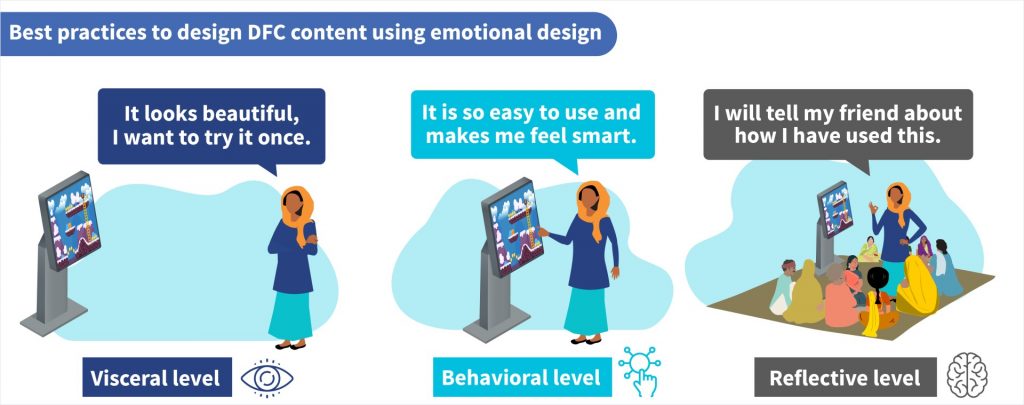Digital financial capability—using emotions to design content
by Surbhi Sood and Ritika Sah
May 22, 2023
6 min
Read this blog to understand the importance of increasing users’ confidence in using digital financial services by using the concept of emotional design to create digital financial capabilities (DFC) content. Emotional designs nudge users to convert long-lasting attitudes into actions. They encompass three levels: visceral, behavioral, and reflective. Through a series of illustrative examples, the blog also presents insights to enable the design of impactful DFC interventions.
We were in the middle of a digital financial capability (DFC) session in the Kerwari village of Jaunpur, Uttar Pradesh, India. Our team was conducting an interactive activity to help rural women understand how to make digital transactions using a mobile phone. In the middle of the activity, Revati, a participant, called out and asked us, “What is the use of teaching us all this when we all know is that we are scared of using mobile phones to make payments.”
Figure 1: Picture from fieldwork in Kerwari village Figure 2: User interface prototypes for mobile applications, for activity purposes
Awestruck by Revati’s question, we brainstormed a possible solution after the fieldwork ended. However, it took us a while to realize that we might have to delve deeper to address some critical behavioral issues Revati brought to light.
MSC’s study and other studies also highlight the importance of behavioral biases in adapting financial services. One of the objectives of DFC interventions is to increase the user’s confidence in using digital financial services independently and skillfully. This confidence enables them to protect their money against fraud, safeguard their data, and understand and use digital interfaces.
Moreover, based on our experience working with multiple providers, we understand that providers focus considerably on increasing the user’s confidence by upgrading user knowledge and skills but often focus little on changing the user attitude. A user’s attitude includes attitudes toward accessing or using digital financial services (DFS) and their risks. It also includes attitudes toward a greater need for DFC after COVID-19. Therefore, a strategic focus on intuitive content design (detailed below) and compatible delivery (described in this blog) will help practitioners build better DFC interventions to change attitudes.
Research also reveals that attitudes based on emotions can stand the test of time, and these emotions are essential for financial decision-making. Emotional designs result in a positive user experience. DFC content with emotional designs nudges users to convert long-lasting attitudes or beliefs into actions. Don Norman mentions that the emotional system comprise three different yet interconnected levels, each influencing our experience in a particular way. The three levels are visceral, behavioral, and reflective, and DFC content that caters to all these levels should impact attitudes.
Figure 3: Best practices to design DFC content using emotional design
Level 1: Visceral
Visceral aspects form the first impression of the DFC content. Visceral aspects focus on appearance, including expressive colors, immersive sounds, and intuitive touch. The solution’s visceral quality establishes its first emotional connection with the target segment. The visceral design also helps build trustworthiness and gain traction from the target segment. For DFC interventions, visceral aspects are often presented as attractive and colorful animated videos, comic books, and cartoon strips. However, the target segment must relate to these representations, or they may lead to an instant emotional disconnect.

Level 2: Behavioral
The behavioral level is about usability. It refers to the content’s practical and functional aspects that help change behavior. Good behavioral design is like a lock and key. Customer behavior is the lock, content is the key, and harmony exists when the two work smoothly. Conventional DFC content focuses on imbibing behavior toward budgeting, opting for cheaper loans, or registering for insurance. However, the vulnerable income groups have volatile income and expenses. Therefore, financial decisions focus less on creating a stable budget and more on making ends meet.
MSC’s support to HFC Kenya resulted in the use of behavioral design to integrate DFC into its mobile banking application’s user interface. The MSC team used their proprietary Market-Insights for Innovation and Design (MI4ID) approach to redesign the menu options in the application, which focused on use-cases, such as borrow, invest, spend, store, and protect, making the user interface more intuitive. In addition, they simplified the interface with calculators to help budget for deposit and credit requirements so that the mobile application can also help improve customers’ overall financial health.
We can use a few high-impact emotional biases to influence behavior through DFC content design:
- The vulnerable segment is more sensitive to small losses than significant gains. Loss aversion explains why people deposit their money with local groups rather than banks. Thus, they avoid losing prospective financial support from their communities in times of need;
- Most financial service users exhibit status quo bias and are motivated to try DFS for the first time only when it negatively affects their reputation;
- The user seeks social proofing from a trusted person before using DFS;
- Scarcity bias is a predominant bias among the vulnerable segment leading to an ongoing struggle to deal with limited resources at the expense of planning long-term goals.
Please note this list is not exhaustive. We have listed only a few common behavioral traits of the LMI segment, and each customer segment has specific characteristics.
We use our understanding of behavioral science to develop interactive nudges or counter-arguments addressing behavioral biases. However, we must understand that the content’s usability differs widely among target segments. For example, the content presented as a gaming application may serve literate youth adequately, while a simple IVR-based solution can prove complicated for illiterate rural women. Read the next blog in this series to learn more about various channels for DFC programs in detail.
Level 3: Reflective
Reflective content is the highest level of a design’s emotional state, which helps the target segment instill a deeper meaning in the content as it directly impacts their System 2 thinking. The target segment consciously approaches the presented content, weighs its pros and cons, and extracts relatable information. This level also addresses deep-rooted fears among the target segment related to DFS and helps them identify how to overcome them.
We use heuristics to simplify complex decision-making to help target segments further rationalize the presented content. While developing content for a community-led DFC intervention, MSC developed a meaningful and straightforward rule of thumb to help entrepreneurs retain essential information, which translated to changes in how they use financial services. MSC also trained the Financial Service Providers (FSP) staff as mentors to help them use this rule.

The pilot design includes the following:
- Carefully crafted prototypes for experimentation. See women participating in an ATM prototype exercise in the picture on the right.
- Content aligned to overcoming cultural fear by disseminating content through activities for the group to solve, helping inculcate DFS usage into daily lives.
Further, the pilot is expected to help build confidence among low-income women and the farmer population for DFS usage.
A DFC intervention that incorporates all three emotional design levels into the content of the DFC solution can help users like Revati absorb DFC content better for the effective use of DFS. Therefore, an ideal DFC intervention will include an attractive, easy-to-use solution incorporated into daily chores. The intervention should focus explicitly on incorporating social proofing to address the fear of conducting DFS transactions for Revati and countless others like her.
Read our next blog that identifies appropriate digital channels to disseminate DFC content that triggers all levels of our emotional system.
Written by

 by
by  May 22, 2023
May 22, 2023 6 min
6 min 



Leave comments